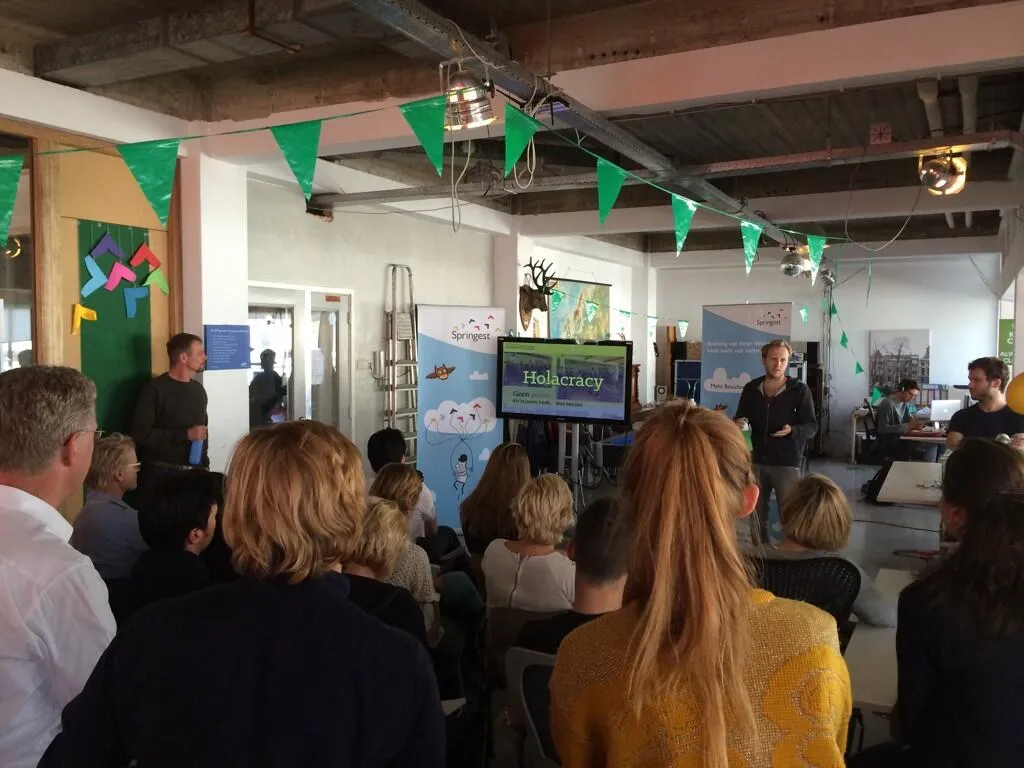How to Get More Out of Holacracy
Some Pointers for Mature Holacracy Practitioners
Some Pointers for Mature Holacracy Practitioners

Springest presenting Holacracy to visitors during OpenCo 2014 in Amsterdam
2.5 years into Holacracy, Springest recently asked me to challenge them on what more they could get out of it. From the 20+ organizations I’ve coached on Holacracy to date, I consider Springest one of the most mature practitioners, so I enjoyed giving this some thought.
With more and more organizations practicing Holacracy, I figured these pointers might be of interest to others, so here goes!
Increase ‘role entrepreneurship’, meaning the extent to which you’re pro-actively leading your roles rather than ‘just doing them.’ Here are four things you can do to become more of an entrepreneur in your roles:
Evolve your governance according to purpose, more than functions, products, etc. Thinking about where that new accountability should live? Focus on the purpose it serves, more than just the discipline, function, or product it happens to falls under.
Same thing for metrics: they should tell you how well you’re expressing the purpose of the circle and of your roles within it. Is it clear what the purpose is? How would you know if you’re getting better at expressing it, or worse? What key indicators can you regularly look at to take the pulse of your circle?
Every now and then in your weekly review (your GTD-style ‘meeting with yourself’), review the purpose of your roles, rather than “just” focusing on your accountabilities, projects, and next-actions. What’s getting in the way of more powerfully expressing your role’s purpose? What else could you be doing, that would also serve that purpose? Identify projects and next-actions proactively, even if you don’t have time to do them now. Include them in your trusted system and possibly on your circle’s projects board, so they become visible and you can begin to consider them when you’re prioritizing your work.
Identify what’s getting in the way of being better sensors, individually and collectively, and take steps to remove those barriers. Holacracy is all about tension-processing, and the quality of your decisions is a factor of how sensitive you are to things that could be better (tensions), and how disciplined you are at processing them. Put more bluntly: garbage in, garbage out.
Improve communication between circles by means of the Lead and Rep Link. For example, add a metric ‘Updates from <super-circle>’ to sub-circles, for Lead Links of sub-circles, and ‘Updates from <sub-circle>’ to the super-circle, for Rep Links from sub-circles. (You know you’re a Holacracy nerd when you got that.)
Finally, here are a few fun questions you can ask yourself to figure out if you’re getting all you can out of your Holacracy practice.
Have you ever…
… just ‘given back’ a role that was assigned to you?
… called someone on violating a domain owned by one of your roles?
… proposed to remove a role in governance (because it’s no longer needed, or because you want to consciously cause tension to trigger further evolution)
… boldly asked another role to take on a big, hairy project that would really help you in one of your roles?
… cried during a check-in round? (Or more seriously: is it a safe space where you authentically share what has your attention? Or do you all just go: “Fine. Doing good. Me too. +1.” to get it over with?)
… made a proposal that turned out to be invalid? (See this article in the Holacracy Constitution v4.1)
… raised an objection that turned out to be invalid because you couldn’t specify how it’s limiting you in one of your roles? (See criterion d here)
… seen a Facilitator act as a traffic cop, i.e. using only hand signals to keep tactical and governance meetings on track?
… caught yourself testing your own objection outside of a governance meeting, in your head? (Freak!)
… asked a Lead Link what role he or she is speaking from?
I’d like to thank Ruben Timmerman of Springest for making the request and triggering me to come up with this stuff. Immediately after our meeting, the people filling the ‘Holacracy Ninja’ role at Springest got together and started processing their newly raised tensions into proposals for governance, projects, and next-actions. It truly is a spectacle to behold a bunch of mature Holacracy practitioners at work.
Drop me a line if you have any questions or additional ideas! You can leave a comment here or email me directly at diederick@energized.org.
To learn more about self-management, join a community of pioneers and check out our e-courses → Self-Management Accelerator